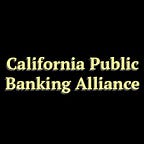This is how to pay for the Green New Deal.
By Sylvia Chi, California Public Banking Alliance
Dianne Feinstein, our Senator, had a viral moment on Friday, February 22, when a video circulated online of her lecturing Bay Area children about why she does not support the Green New Deal. The children were her constituents, on a visit to her office as part of an action coordinated with Sunrise Movement Bay Area, a youth-led climate movement. Sen. Feinstein told them, “There’s no way to pay for it,” and went on to detail how her decades of political experience informed her pessimism on the Green New Deal.
Sen. Feinstein presented the activists with a draft of her alternative resolution, which calls for the United States alone to eliminate greenhouse gas emissions by 2050, far short of the Intergovernmental Panel on Climate Change’s warning to limit global warming to 1.5°C. (Sen. Feinstein has since abandoned this resolution, and Senate Democrats have introduced a simpler “unity” resolution on climate change.)
In contrast, the Green New Deal proposal incorporates economic, industrial, and social justice policies to effect deep, systemic change to decarbonize the country in one decade. And as the name suggests, this type of massive transformation and government intervention has a precedent in the original New Deal, which rescued our country from the worst impacts of the Great Depression. As explained by economist Stephanie Kelton and others, the federal government paid for the New Deal’s massive public investments by exercising its financial sovereignty and creating credit via the Federal Reserve. Moreover, as public banking expert Ellen Brown has highlighted, during the New Deal, the federal government’s Reconstruction Finance Corporation (RFC) lent over $2.5 billion in agricultural loans, backed vast infrastructure investments, and re-stabilized the economy through emergency loans to states and for disaster relief.
The Green New Deal relies on a network of public banks — like a decentralized version of the RFC — as part of the plan to help finance the contemplated public investments. This approach has worked in Germany, where public banks have been integral in financing renewable energy installations and energy efficiency retrofits. And it’s an idea that has taken root in California: last November, over 430,000 Angelenos voted in favor of amending Los Angeles’ city charter as a first step towards a public bank, and Oakland, Berkeley, Richmond, and Alameda County have completed a favorable feasibility study. Sen. Feinstein’s own state director, Jim Lazarus, is a member of San Francisco’s Municipal Bank Task Force, which just completed a year’s worth of research into public banking and is presenting the San Francisco Board of Supervisors a range of public bank models to choose from. The Board — of which Sen. Feinstein used to be a member — recently unanimously passed a resolution in favor of the California Public Banking Alliance’s state legislation for a new charter that will allow cities and counties to establish their own public banks.
How will local or regional public banks help pay for the Green New Deal? They will make low-interest loans for building and upgrading infrastructure, deploying clean energy resources, transforming our food and transportation systems to be more sustainable and accessible, and other projects. The federal government can help by, for example, capitalizing public banks, setting environmental or social responsibility standards for loan programs, or tying tax incentives to participating in public bank loans.
Most importantly, as one of the young activists in the video pointed out, the cost of inaction (or insufficient action) far outweighs the cost of implementing a paradigm-shifting program like the Green New Deal. The Green New Deal’s job training, research and development, retrofitting and infrastructure investments, and technology deployment will stimulate and make our economy more resilient and better adapted for the more frequent wildfires, storms, and heat waves we face right now.
Sylvia Chi is a member of Public Bank East Bay and chair of the legislative committee of the California Public Banking Alliance.
